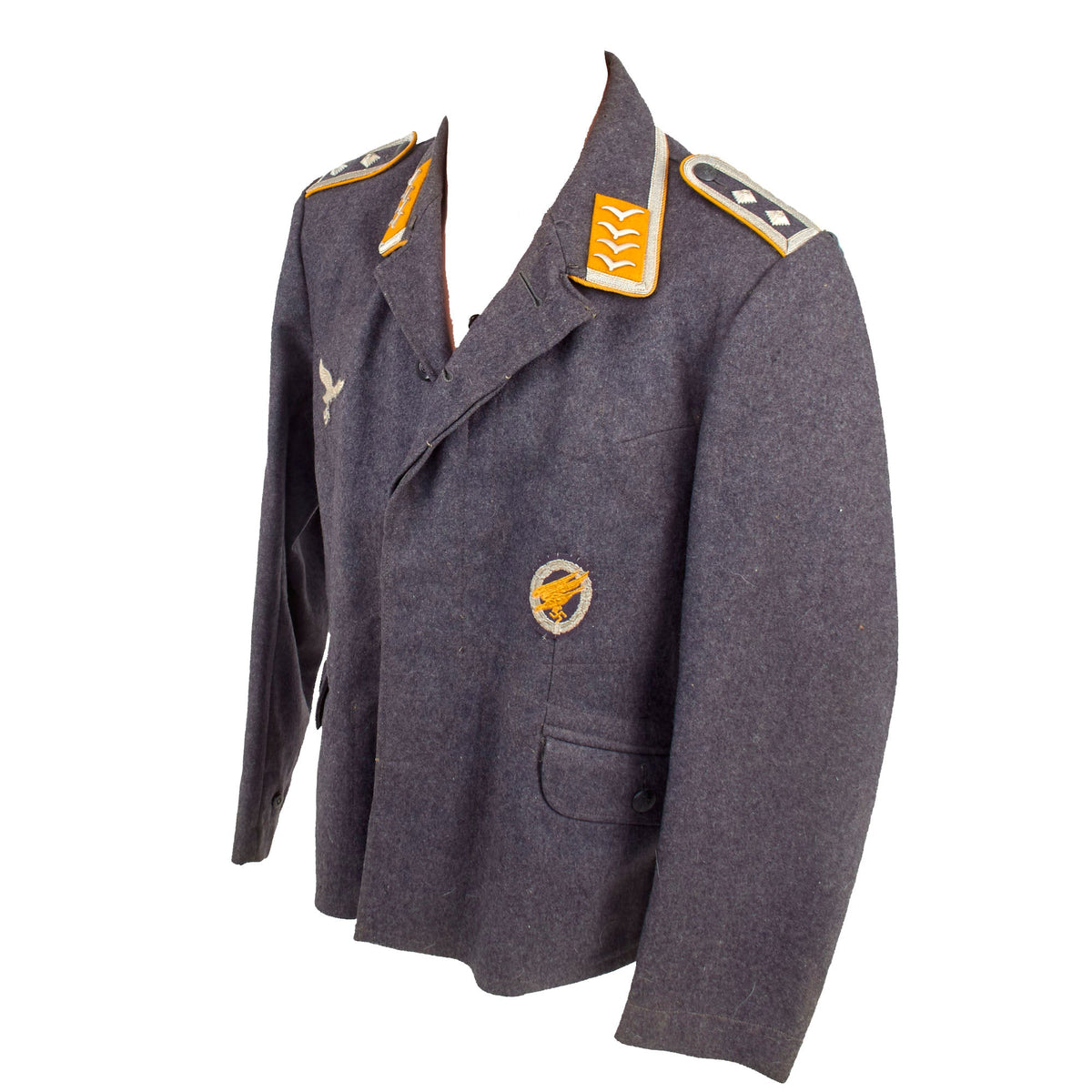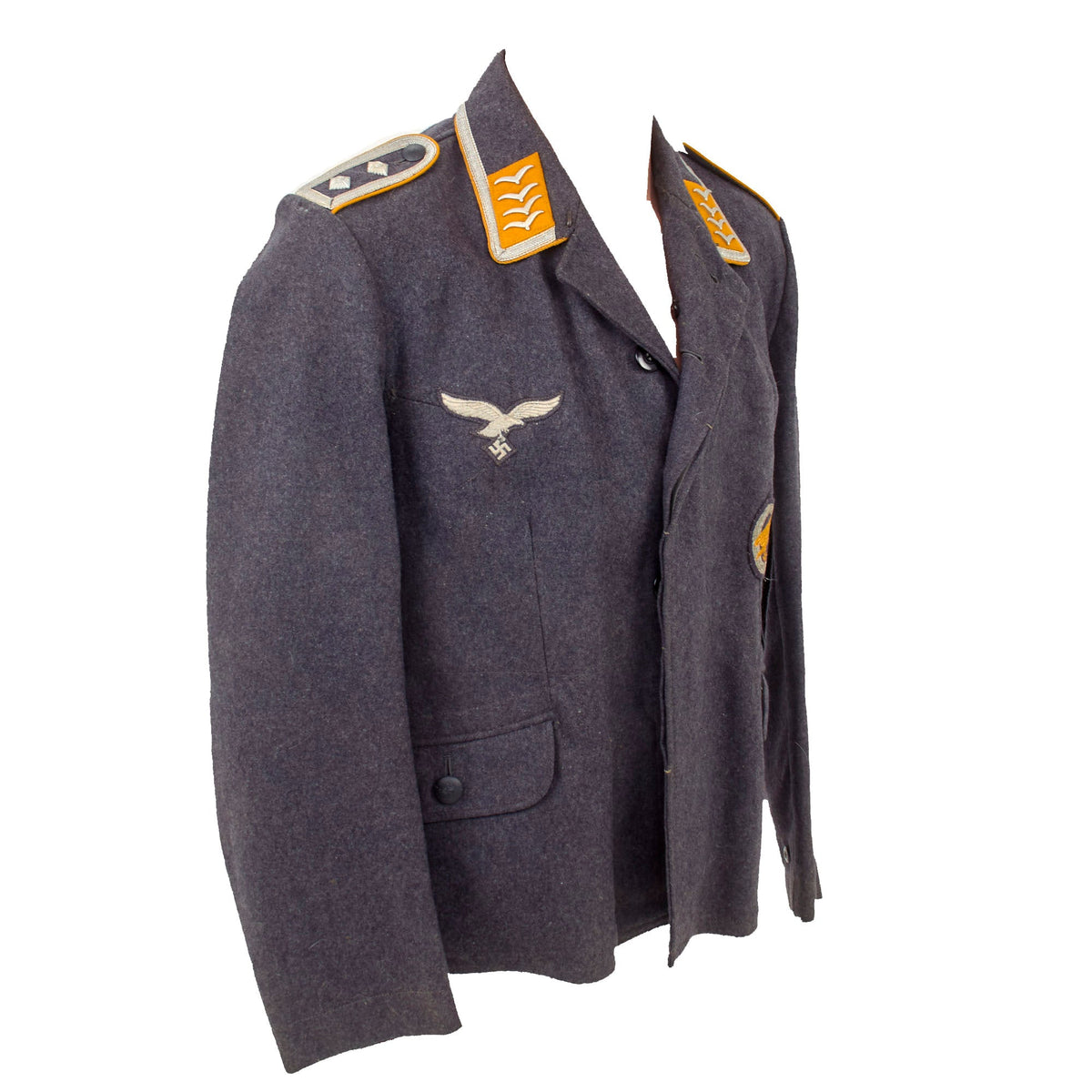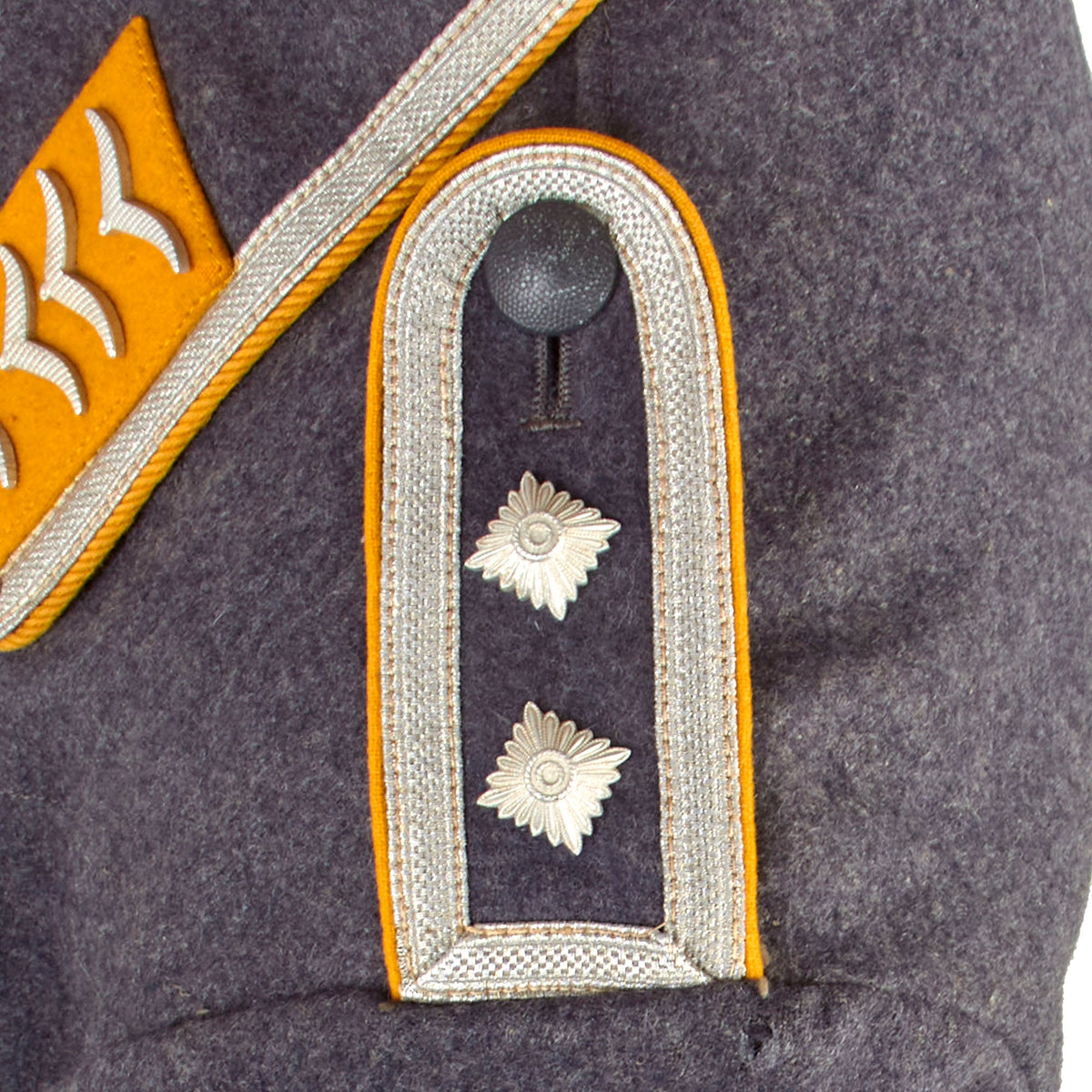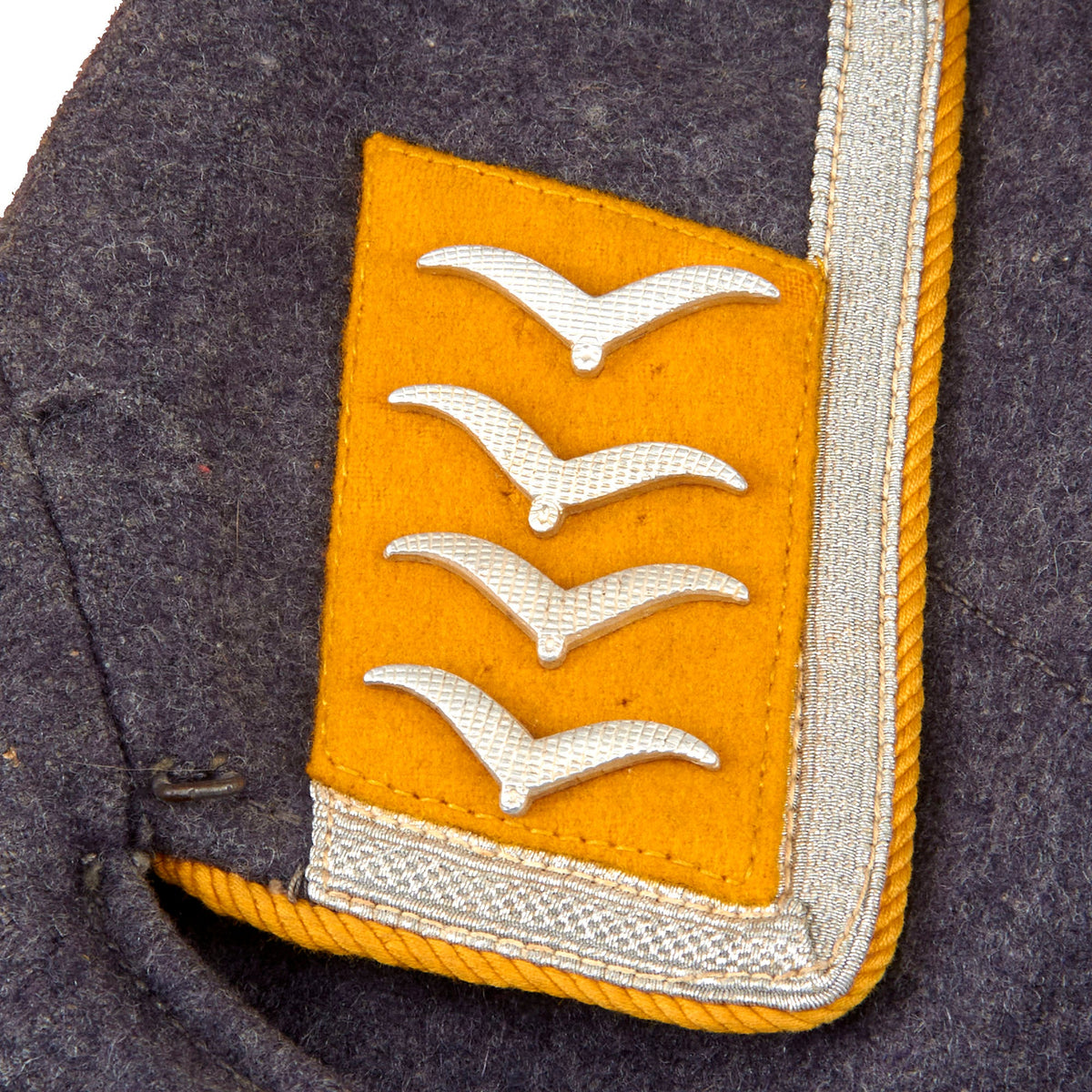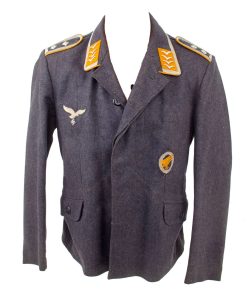Original German WWII Early Luftwaffe Oberfeldwebel NCO Fliegerbluse Tunic with Fallschirmjäger Badge & Parachute Fabric Scarf Original Items
$ 2.495,00 $ 623,75
Original Item: Only One Available. Just acquired from a very well-curated Luftwaffe collection, this is a fantastic WWII German Luftwaffe Flight Branch NCO Two Pocket Fliegerbluse (Flight Blouse) Service Tunic, which comes with a fantastic triangular scarf / kerchief made from camouflage parachute fabric. There is no more fitting scarf for a Fallschirmjäger than one made from his own parachute! The tunic shows moderate wear, showing it was really out there, and not sitting in a depot. It is equipped with a very desirable “hidden” four bakelite button front closure and two waist pockets, which can have the flaps folded in for a a cleaner look. These looked great in service, with a very streamlined look, and it is a relatively short design, somewhat like an “Ike” jacket. It was produced in the standard Fliegerblau (Flyer’s Blue) doeskin weave wool, and really looks great.
The interior of the tunic features blue gray lining and reinforced areas, as is typical of depot issued uniform material. There are two interior chest pockets with button closures on the top, and the left inner chest pocket has faded maker and size markings, which we are unfortunately unable to read. The very top however is marked L.B.A. B1. 41, for the Luftwaffebekleidungsamt, which means Air Force Clothing Office, which would indicate it was issued in 1941, in plenty of time to see some great battles!
The right breast of the uniform has a correct embroidered NCO Luftwaffe eagle sewn in place with the correct stitching pattern. The collar of this officer’s tunic has 10mm wide NCO Tresse flat silver piping going around the entire collar, correct for an NCO fliegerbluse. The attached Kragenpatten (Collar Flaps) are in Goldgelb (Gold-Yellow), as is the collar piping, the correct Waffenfarbe (Corps Color) for Aviator troops such as pilots, air crew, and ground personnel, as well as Fallschirmjäger (parachute troops). The early sew-in style Schulterklappen (Shoulder Boards or Epaulettes) have the same color piping, and a single row of 10mm NCO tress around the outside with two rank “Pips” added, indicating the rank of Oberfeldwebel (Master Sergeant). This is confirmed by the collar insignia, which each show four “gull wing” insignia over a wreath. There is an embroidered Fallschirmschützenabzeichen (Parachutist Badge) on the left side of the tunic, confirming that the wearer was a Fallschirmjäger paratrooper.
Overall condition is really very good, showing light wear, and this is definitely a top example, more than ready for fitting with additional insignia and display. With the included parachute fabric scarf this will make a compelling addition to any collection!
The Parachutist Badge (Fallschirmschützenabzeichen) was a badge awarded to qualified parachutists of the Wehrmacht and the Waffen-SS of NSDAP Germany. The badge was first established by order of Hermann Göring on 5 November 1936. It was originally awarded to Luftwaffe personnel after completion of the required number of six jumps. After this they were eligible to become a Fallschirmjäger (paratrooper).
The badge depicted a diving eagle with a swas in its claws surrounded by a silver wreath. The original construction was made of “gold-finished bronze” for the eagle and “oxidized silver plate” for the laurel leaves. In 1937, the construction of the badge changed to aluminium. In late 1942, the construction was changed again to a metal alloy. A cloth version of the badge was also authorized in 1937, to be worn on a flight jacket. A recipient had to re-qualify for the badge each year.
An army version (Fallschirmschützen-Abzeichen des Heeres) was later introduced (1 September 1937), with the swas relocated to the top of the wreath and surmounted by a smaller upright eagle. As with the Luftwaffe, a recipient had to re-qualify for the badge each year. In 1936, the army ordered the institution of its own parachute company, which was expanded to a battalion in 1938. When the army parachute units were transferred over to the Luftwaffe in 1939, the former army soldiers continued to wear the army version of the Parachutist badge. The Waffen-SS personnel of the 500, 501 or 502 SS-Parachute Battalions were awarded the Luftwaffe badge after they passed the jump and other test requirements
The term Fallschirmjäger, often written Fallschirmjaeger in English, is from the German Fallschirm “parachute” and Jäger, the light elite infantry of the Prussian army. This term was then applied to all German paratroopers. Fallschirmjäger of Germany in World War II, were the first to be committed in large-scale airborne operations. They came to be known as the “Green Devils” by the Allied forces they fought against and were some of the best trained most lethal troops of the German war machine.
The Luftwaffe, the air force of the German military during the Third Reich, was established in 1935. Over the next 10 years, Luftwaffe troops wore a huge variety of uniforms. Enlisted men generally wore uniforms issued from military depots. Most enlisted soldiers had wool trousers and a short jacket with two internal lower pockets, called a Fliegerbluse, as well as a dressier 4-pocket tunic, the Tuchrock. Officers wore the same general uniform styles, but as officers had to supply their own uniforms, they usually wore tailor made versions. There were also myriad varieties of specialized uniforms worn by certain units or in specific situations, from the tuxedo-style “gala” formal wear uniform of the pre-war period, to the plain coveralls worn by crews of anti-aircraft cannons. There were work uniforms, tropical and summer uniforms, and camouflage clothing for airborne troops and other Luftwaffe soldiers in ground combat. Flight crews had their own specialized gear, including leather jackets and warm, electrically heated suits. Most but not all Luftwaffe uniform jackets bore the Luftwaffe emblem of a flying eagle holding a swas.
Fast Shipping with Professional Packaging
Thanks to our longstanding association with UPS FedEx DHL, and other major international carriers, we are able to provide a range of shipping options. Our warehouse staff is expertly trained and will wrap your products according to our exact and precise specifications. Prior to shipping, your goods will be thoroughly examined and securely secured. We ship to thousands clients each day across multiple countries. This shows how we're dedicated to be the largest retailer on the internet. Warehouses and distribution centres can be located throughout Europe as well as the USA.
Note: Orders with more than one item will be assigned a processing date depending on the item.
Before shipping before shipping, we'll conduct a thorough inspection of the items you have ordered. Today, the majority of orders will be delivered within 48 hours. The delivery time will be between 3-7 days.
Returns
The stock is dynamic and we cannot completely manage it because multiple stakeholders are involved, including our factory and warehouse. So the actual stock may alter at any time. It's possible that you may not receive your order once the order has been made.
Our policy is valid for a period of 30 days. If you don't receive the product within 30 days, we are not able to issue a refund or an exchange.
You can only return an item if it is unused and in the same state as the day you received it. You must have the item in its original packaging.
Related products
Uncategorized
Armored Burgonet Helmet & Polearm from Scottish Castle Leith Hall Circa 1700 Original Items
Uncategorized
Uncategorized
Uncategorized
Uncategorized
Uncategorized
Uncategorized
Armoured Fighting Vehicles of the World: AFVs of World War One (Hardcover Book) New Made Items
Uncategorized
Uncategorized
Uncategorized
Uncategorized
Uncategorized
Uncategorized
Uncategorized
Uncategorized
Uncategorized
Uncategorized
Australian WWII Owen MK1 Machine Carbine SMG Custom Fabricated Replica with Sling Original Items
Uncategorized
Uncategorized
Angolan Rebel 1970s era 60mm Inert Display Mortar from Angolan Civil War Original Items

